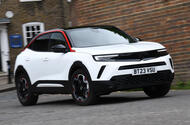
Frumpy crossover turns into something of a style icon. Does it have substance, too?
Compact crossover, or a raised hatchback? There are lots of ways you can feasibly describe the second-generation Vauxhall Mokka, which has swiftly risen to become one of the brand’s most popular cars in the UK and Europe. If you remember the first Vauxhall Mokka, built from 2012-2019, you’d be forgiven for not having high hopes for this new version. But make no mistake – it’s a vastly different proposition than the model it has replaced, with technology from Stellantis, an eye-catching and stylish exterior design, and much more. Now, it sits alongside a strong model line-up consisting of the former UK best-selling Vauxhall Corsa, the soon-to-be-updated Grandland and the upcoming, revived Frontera. It’s such a different prospect from the car it replaces that you wonder if Mokka owners will even recognise it. In case they don’t, Vauxhall has handily written the model name in large capital letters across the boot lid, in the vein of Skoda, Porsche and others. The old Mokka – a high-roofed, big-boned sort of car in what is known to some as the B-SUV niche – was a surprise sales hit in Europe, with more than 200,000 finding homes in the UK alone.The public has responded well to the new version too, shifting over 100,000 units in Europe in 2023. It’s succeeding in its statement to flex some atrophied design muscle and invite people to consider a Vauxhall who might never have before.Read on, then, to find out how much more than meets the eye there is to discover here.The Vauxhall Mokka line-up at a glanceThe Mokka launched with a choice of petrol and diesel, but the latter has now been removed from the range. Today, it’s available as a pure-petrol car or with an electrified hybrid powertrain, plus there’s the all-electric Vauxhall Mokka-e. VersionPower1.2 turbo petrol 100PS manual98bhp1.2 turbo petrol 136PS manual 6-spd134bhp1.2 turbo petrol 130PS automatic 8-spd128bhpHybrid 1.2 136PS e-DCT6 dual-clutch 6-spd134bhp
Source: Autocar